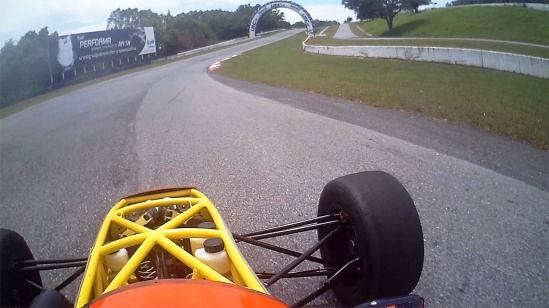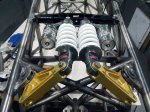After five long years of work, the car finally made it to the track!
On Tuesday, August 11 we did a shared-track day at Bira International Circuit in Pattaya, Thailand. The trailer’s not finished, nor do I have a tow vehicle yet, so we had a slide truck pick the car up and deliver it to the track. Bira’s only five minutes from my house, so this was easy.
So here we are at the track with a car designed from a clean sheet of paper, a prototype that’s never turned a wheel, a driver who’s ever driven only one lap of this course in a Honda Jazz/Fit several year ago, who’s never driven a sequential transmission, hasn’t been in a race car in 14 years, never driven with race tires, and tires, in fact, that were bought used several years ago. Also, springs and shocks that turned out to be way too stiff, and no front wing, rear wing, sidepods, or diffuser. Yeah! Let’s go!
Surprisingly enough, the test went great! Through various friends I had four mechanics helping me, three of whom were experienced race car mechanics. Before going out the mechanics went over the car carefully and found a small gas leak at the fuel tank and a slight oil leak at the oil pressure sensor, but those were soon fixed. I did one slow lap, starting to bed in the brakes, then came in for a check. Then I did another 8 laps to finish bedding-in the brakes and brought the car in for a complete check. At that point we had to adjust the drive chain tension.
After I rested I went out again for several more laps trying to bring the speed up, doing a best lap around 1:28, still very slow for Bira. I brought the car in when my neck couldn’t take it anymore, after only about six laps. The issue was not so much cornering force as it was the wind pushing my helmet backwards; I just couldn’t hold my head up against it. We found a few issues like the torque spec on the left front wheel bearing was not high enough, leaving the axle free to wobble a bit in the bearing. Also, the left rear lug nut backed off, and the throttle cable came loose at the engine bracket. We increased the lug nut torque spec and reversed all the nuts so the flat side contacted the wheel as we decided the radius on the wheel was too small to properly contact the conical face of the nuts.
For the third run I brought the speed up more, with a best lap of about 1:21, but the car was undrivable at high speed. I believe it was actually bouncing in the air on the straight, as I could hear engine speed variations even when I wasn’t touching the clutch or gear lever. I kind of expected something like this as the springs are way too stiff. Anyway, the stiff springs bent the right rear suspension pushrod adjuster, and we were done for the day.
So overall, the suspension geometry feels perfect. The engine, transmission, electrical system, frame, steering, cooling and almost everything else worked flawlessly.
Wow, it fast! It’s the most amazing thing I’ve ever driven. It makes my old twin-plug 3.5 liter Porsche 930 feel like a tractor. But it demands precision and skill– I felt like an elephant learning to tap dance. As I’m sure you will see from the video, my shifting was all wrong. All the action in the clutch is in the first half inch, whereas the throttle pedal moves like four inches so coordinating the two was difficult. In addition, I was still driving it like a normal transmission, using the clutch on upshifts, as we decided to learn proper sequential shifting in a later test. I can see that with some suspension tuning, aerodynamics, tires, and a software upgrade for the nut that holds the steering wheel, the car will be seriously fast.
Thanks to everyone on Apexspeed who has provided advice, technical knowledge, and emotional support over the years. I couldn’t have done it without you!





























